When serving salmon, plain rice can sometimes feel a little… boring. While it’s a classic side, it doesn’t bring out the best in salmon unless it’s seasoned properly. A few simple tweaks can completely transform your rice from bland to bright, flavorful, and restaurant-worthy — elevating the entire meal.

Salmon is flavorful on its own. So, the best rice pairing needs to be light, fresh, and gently seasoned. You want the rice to complement the salmon, not overpower it. That’s why additions like lemon zest, fresh herbs, garlic, and a touch of butter make such a big difference.
With just a few basic ingredients and techniques, you can create simple seasoned rice for seafood that feels gourmet but is actually very easy to make at home.
My seasoning tips will help you in enjoying the salmon taste more than before and you really appreciate these seasonings .
But before we start , tell me are you salmon lover and do you like salmon recipes , if yes , so you should try my
Best Types of Rice for Serving with Salmon
Choosing the right type of rice is key to creating the perfect side dish for salmon. Not all rice is created equal — some varieties are better suited for seafood dishes because of their texture, aroma, and lightness.
Jasmine Rice
Jasmine rice is naturally fragrant, light, and fluffy. It is best for recipes where you want the seasoning to shine without the rice becoming too heavy.Rinse jasmine rice before cooking to remove excess starch and keep it fluffy.
Basmati Rice
It holds seasonings like herbs and citrus very well. It is best for Herb-infused rice, lemon dill rice, or light pilaf recipes alongside grilled or baked salmon.
Wild Rice (or Wild Rice Blends)
Wild rice offers a chewy texture and a flavor that compliments salmon dishes, especially when salmon is smoked or heavily seasoned. It pairs well with roasted salmon, mushroom sauces, or autumn-style recipes.
Brown Rice
It brings more fiber and a wholesome element to the meal. It is best for healthier, everyday meals where you want a more nutritious pairing without losing flavor.
Why Fluffy, Aromatic Rice Works Best:
You want the rice to act as a flavor carrier — absorbing delicate butter, herbs, and citrus without getting sticky or dense. Fluffy, aromatic rice makes each bite feel light, fresh, and perfectly balanced with the rich taste of salmon.
Essential Ingredients to Season Rice for Fish
When preparing rice to pair with salmon, it’s all about balancing flavor and freshness. Here’s how you can elevate plain rice with just a few key ingredients:
1. Lemon Juice and Zest
The acidity of lemon juice is perfect for cutting through the rich, buttery flavor of salmon. The zest contains the essential oils from the lemon peel, which offer a more intense citrus fragrance and flavor. It’s not as acidic as the juice but provides a wonderful aromatic lift to the rice, making it more fragrant and flavorful.

You can use both for the most flavorful effect. Add fresh lemon juice to the rice just before serving, as it will add freshness. Then, mix in some lemon zest to enhance the flavor.
Zest the lemon before juicing it, and stir the zest into the rice while it’s still warm to allow the oils to release. Lemon juice can be stirred in after cooking or just before serving to keep the fresh, bright flavor.
2. Fresh Herbs (Dill, Parsley, Cilantro)
Dill: Dill is a classic herb for fish, especially salmon. Its aromatic, fresh qualities cut through the fat of the fish and rice, offering a refreshing contrast. Its natural affinity with salmon makes it a must-use herb in any seafood dish.
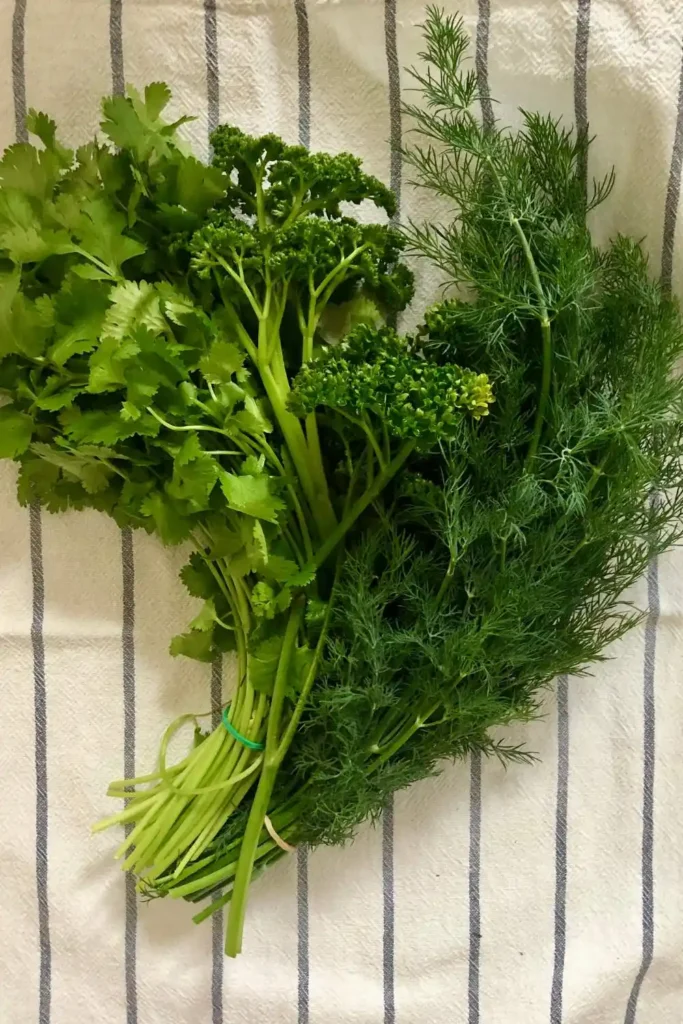
Parsley: Parsley is a versatile herb that adds freshness without overpowering other flavors. It is especially good for giving the rice a clean finish, making the dish feel light and well-rounded.
Cilantro: Cilantro has a citrusy and slightly spicy flavor, which pairs exceptionally well with the citrusy elements of your dish (like lemon juice or zest).
How to Use Them:
Preparation:
Start by washing and drying the herbs properly to ensure you don’t add excess moisture to your rice. Chop the herbs finely to ensure they distribute evenly throughout the rice. This ensures each bite of rice is infused with the herb’s flavor.
Add the chopped fresh herbs just before serving. This helps preserve their bright, fresh flavors, as heat can diminish their potency. Stir them in gently so the herbs are well-distributed without overmixing. You want the rice to remain fluffy with small bursts of fresh herb flavor in each bite.
Which Herb to Use:
Dill: Perfect for lemon herb rice or any citrus-based rice. Use 2–3 tablespoons of fresh dill for a balanced flavor without overwhelming the dish.
Parsley: Ideal for both lemon and garlic butter rice. Add 2 tablespoons of finely chopped parsley for a clean, neutral fresh flavor.
Cilantro: Best for a citrus rice recipe. A tablespoon or two of chopped cilantro will bring a lively kick without overpowering the rice.
Blending Flavors:
Lemon Herb Rice: Use a combination of dill and parsley for a perfectly balanced fresh herb mix.
Garlic Butter Rice: If you’re using a rich, garlicky butter rice, parsley and a little dill will balance out the richness and keep the dish feeling light and refreshing.
Extra Tips:
Don’t cook the herbs: Heat will cause fresh herbs to lose their bright, fresh flavor. Always add them after the rice has finished cooking.
Use the right herbs for the season: For a winter meal, parsley and dill are perfect. For a summer dish, cilantro adds a refreshing taste, especially if you’re pairing it with citrusy rice.
Butter, Olive Oil, or Garlic
A little fat is key to making rice and these ingredients help bring out the flavor of the herbs and citrus. Butter provides a creamy feel, while olive oil adds a fruity richness. Garlic brings a savory depth that pairs wonderfully with the fish.
For a garlic butter rice, melt butter in a pan and sauté minced garlic until fragrant, then stir the mixture into your rice. For a lighter option, drizzle olive oil on the rice and top with herbs.
Light Seasonings (Salt, Pepper, Broth)
Why it works: To keep the rice from overpowering the salmon, simple seasonings like salt and pepper are essential. They enhance the other flavors without competing with the fish. If you want to add more flavor, chicken or vegetable broth is a great addition to your rice cooking liquid.
How to use: Season your rice with salt and pepper to taste. To add even more flavor, use broth instead of water when cooking your rice.
Easy Flavored Rice Recipes for Salmon
Garlic Butter Rice for Salmon
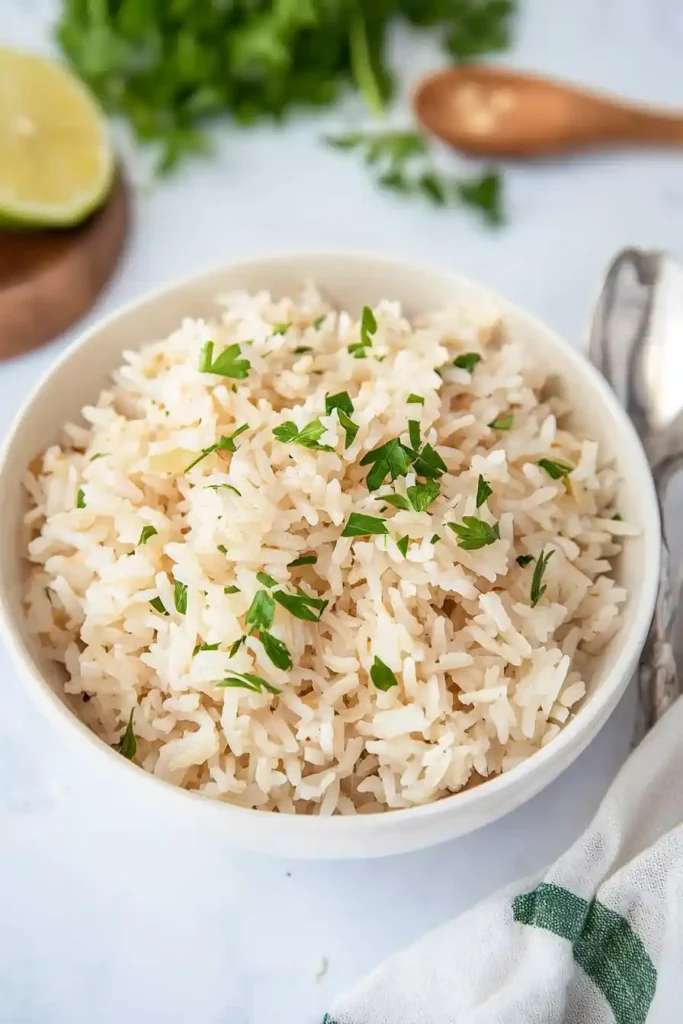
Ingredients:
- Rice – Choose your preferred rice (like white rice, jasmine, or basmati) for this dish. You’ll need about 1 cup of cooked rice for a serving size that works well with salmon.
- Butter – 2 tablespoons of unsalted butter.
- Garlic – 2–3 cloves of fresh garlic, minced.
- Salt – 1/4 teaspoon (or to taste).
- Pepper – Freshly ground black pepper, about 1/4 teaspoon.
- Chopped Parsley – 2 tablespoons (optional).
How to Make Garlic Butter Rice for Salmon
Prepare the Rice:
If you haven’t cooked your rice yet, cook the rice according to package instructions. Ideally, use a fluffy rice like jasmine or basmati that will absorb the garlic butter mixture well. Once cooked, fluff the rice with a fork and set it aside.
Sauté Garlic in Butter:
In a medium skillet, melt 2 tablespoons of unsalted butter over medium heat.
Minced garlic: Add the 2–3 cloves of minced garlic to the skillet once the butter has melted. Stir it around to coat it with the butter. Let the garlic cook for about 1–2 minutes or until it becomes fragrant. Be careful not to burn it—garlic can turn bitter if overcooked.
Add the Cooked Rice:
Add the cooked rice into the skillet, directly on top of the butter-garlic mixture. Stir the rice around, making sure that each grain is coated evenly with the butter and garlic. The heat from the rice will help absorb the flavors of the butter and garlic, giving it a rich, aromatic flavor.
Season the Rice:
- Salt: Sprinkle 1/4 teaspoon of salt over the rice.
- Pepper: Add 1/4 teaspoon of freshly ground black pepper to the rice.
- Stir everything together until the rice is evenly seasoned.
Garnish and Serve:
Once everything is well combined and the rice is heated through, remove it from the heat. Chopped parsley: Sprinkle 2 tablespoons of fresh parsley on top for a fresh finish..
Butter and Herb Rice Pilaf
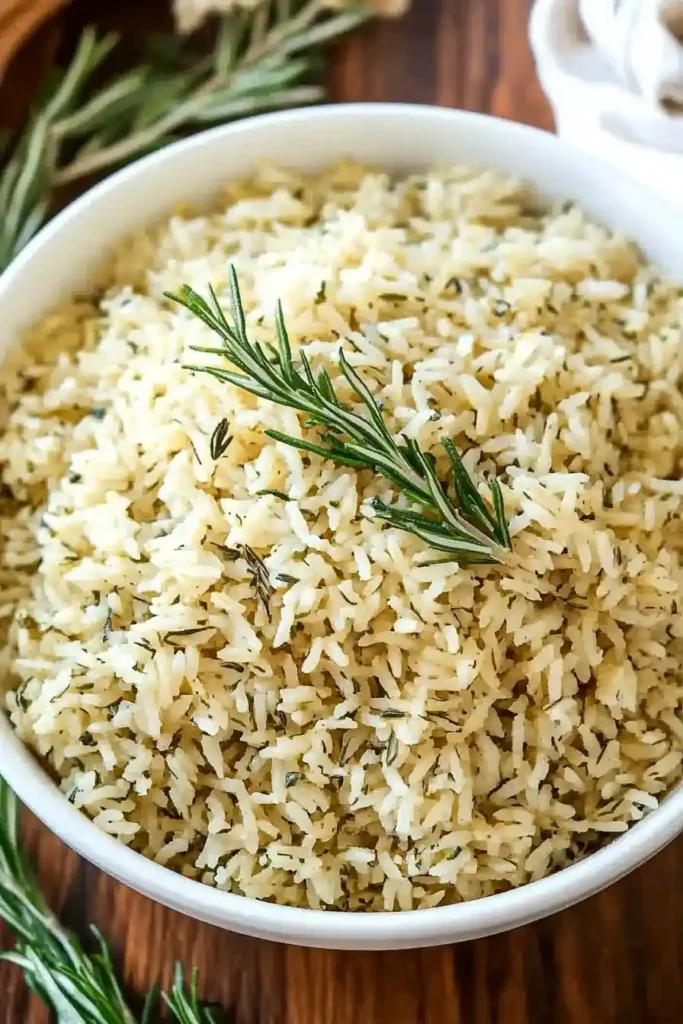
While it feels a bit more refined, it’s still easy to prepare, making it a perfect pairing for your salmon.
Ingredients:
- Rice – 1 cup long-grain white rice (or Basmati rice for extra fragrance). Long-grain rice is best because it remains fluffy and doesn’t clump together, making it ideal for pilaf.
- Butter – 2 tablespoons of unsalted butter.
- Chicken Broth – 2 cups of chicken broth (or vegetable broth for a lighter option).
- Fresh Herbs – 1 teaspoon of fresh thyme (or a mix of thyme, rosemary, or parsley).
- Lemon Juice – 1 tablespoon of fresh lemon juice.
- Salt and Pepper – To taste.
- Extra Butter and Herbs (Optional) – 1 tablespoon of butter and fresh chopped herbs for garnishing.
How to Make Butter and Herb Rice Pilaf:
Toast the Rice:
Start by melting 2 tablespoons of butter in a large saucepan or skillet over medium heat.Once the butter is melted and bubbly, add 1 cup of long-grain white rice (or Basmati) to the pan.
Stir the rice in the butter for 3–5 minutes until the rice turns lightly golden and starts to release a nutty aroma. This step helps to develop a toasted, slightly nutty flavor in the rice, which is key for pilaf.
Add Chicken Broth:
Once the rice is toasted, pour in 2 cups of chicken broth. Stir to combine, and bring the mixture to a gentle simmer.
Reduce the heat to low, then cover the pan with a lid and let the rice simmer for 15-18 minutes. Do not stir the rice during this time, as this can cause it to become sticky. Allow the rice to cook until all the liquid is absorbed and the rice is tender.
Add Fresh Herbs:
Once the rice is fully cooked and all the liquid has been absorbed, remove the pan from heat and add your fresh herbs. You can use 1 teaspoon of fresh thyme, but feel free to mix in other herbs like rosemary, parsley, or a combination.
Add 1 tablespoon of fresh lemon juice to the rice. The lemon juice adds a bright, citrusy contrast to the richness of the butter and herbs, balancing the flavors.
Finish with Butter and Herbs:
For a final burst of flavor, add 1 tablespoon of additional butter and stir it into the rice until it melts completely, creating a smooth, rich texture.
If desired, garnish the rice with freshly chopped herbs (such as parsley or more thyme) before serving. This not only enhances the flavor but also adds a beautiful pop of color.
Citrus Rice Recipe
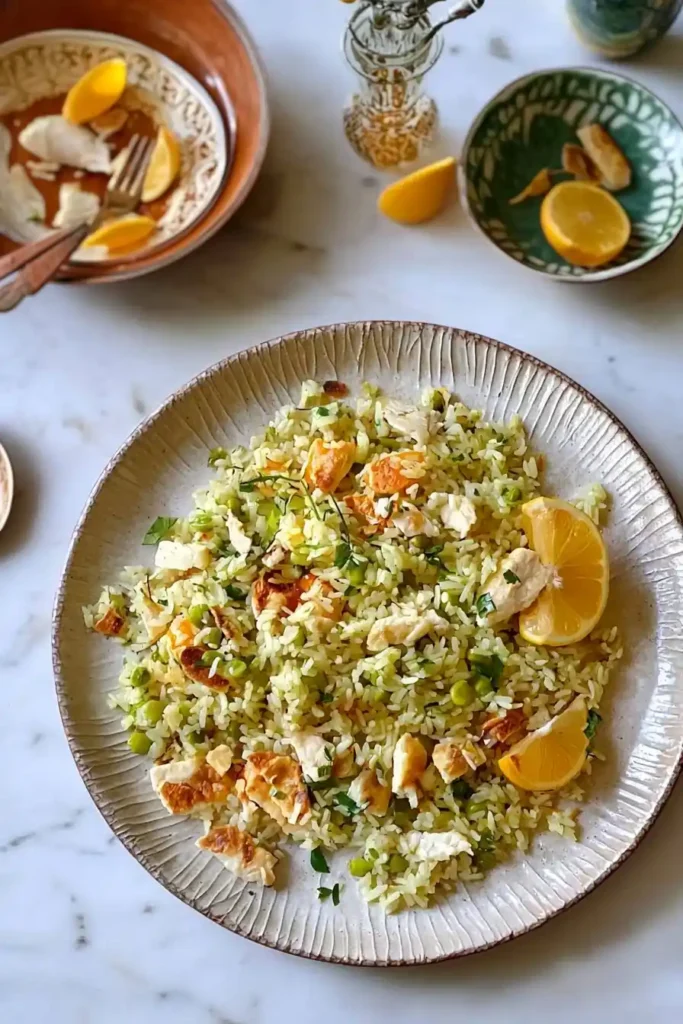
This Citrus Rice is the perfect side dish for salmon, bringing flavors from both lemon and orange.
Ingredients:
- Rice – 1 cup of cooked rice (Jasmine rice works best for its light, fragrant texture, but you can use other types of rice like Basmati or even brown rice).
- Orange Zest – 1 teaspoon of fresh orange zest.
- Orange Juice – 2 tablespoons of fresh orange juice.
- Lemon Zest – 1 teaspoon of lemon zest.
- Coconut Oil (or Butter) – 1 tablespoon of coconut oil (or melted butter).
- Chopped Cilantro or Mint – 1 tablespoon of finely chopped cilantro or mint.
- Salt and Pepper – To taste.
How to Make Citrus Rice for Salmon
Cook the Rice:
Start by cooking 1 cup of rice according to the package instructions. For Jasmine rice, use a 1:1.5 rice to water ratio, or follow the specific instructions on the package. If you’re using leftover rice, make sure to reheat it thoroughly before adding the citrus flavors.
Add the Zests and Juices:
Once the rice is cooked, add 1 teaspoon of fresh orange zest and 1 teaspoon of lemon zest. Be sure to only zest the outermost, colorful part of the fruit’s peel—avoid the bitter white pith.
Stir in 2 tablespoons of fresh orange juice to give the rice a tangy, citrusy punch. This will infuse the rice with a tropical, sweet, and slightly tart flavor.
Add Coconut Oil (or Butter):
For a touch of tropical richness, stir in 1 tablespoon of coconut oil (for a more authentic tropical flavor) or melted butter (for a more traditional creamy texture).
Stir the oil or butter into the rice so that it coats each grain, creating a silky, slightly rich texture.
Garnish with Fresh Herbs:
After mixing the citrus and coconut oil (or butter), finely chop 1 tablespoon of cilantro or mint and stir it into the rice. These herbs add a fresh, aromatic element that lifts the dish and pairs wonderfully with the citrus flavors.
You can also garnish the rice with a little more fresh herb on top for a burst of color and extra freshness.
Season to Taste:
Taste the rice and add salt and pepper as needed. Salt enhances the natural citrus flavors, while a pinch of black pepper adds a slight warmth that balances the sweetness of the citrus and coconut.
Lemon Herb Rice
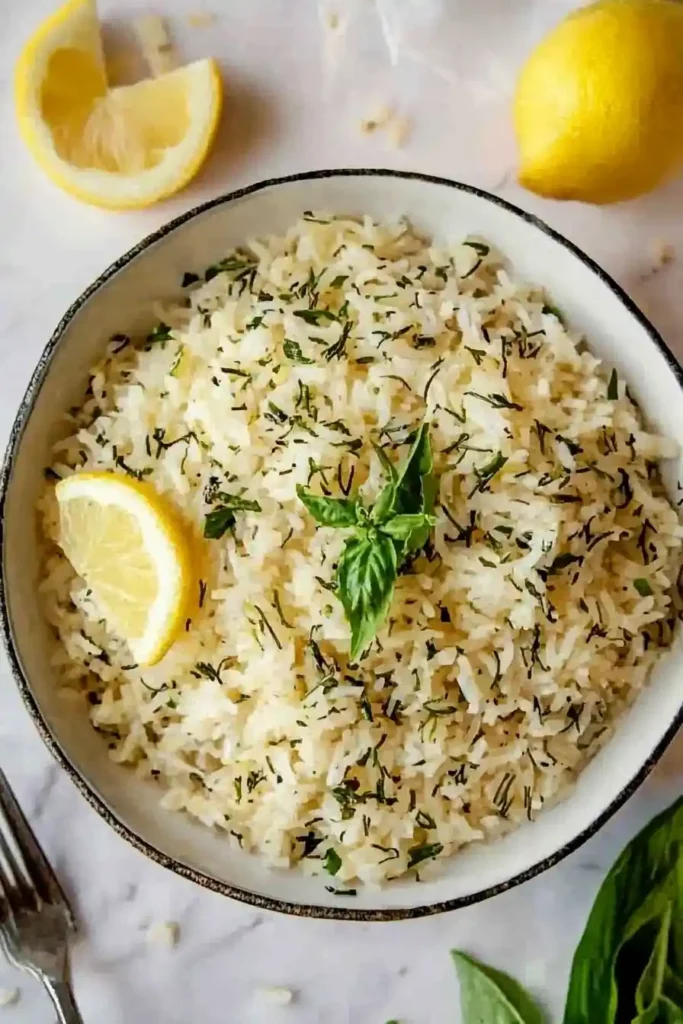
Ingredients:
- Rice – About 1 cup of cooked rice (Jasmine, Basmati, or any preferred rice). You can use freshly cooked rice, or leftover rice if you’re in a pinch.
- Lemon Juice – 2 tablespoons of fresh lemon juice
- Lemon Zest – 1 teaspoon of lemon zest.
- Fresh Dill – 1–2 tablespoons of finely chopped fresh dill.
- Fresh Parsley – 2 tablespoons of finely chopped fresh parsley.
- Olive Oil or Butter – 1 tablespoon of olive oil (or melted butter)..
- Salt and Pepper – To taste.
How to Make Lemon Herb Rice for Salmon:
Cook the Rice:
If you haven’t already cooked the rice, begin by cooking 1 cup of rice according to the package instructions. For a light, fluffy result, use a 1:2 rice to water ratio (for example, 1 cup rice to 2 cups water). If you’re using leftover rice, ensure it’s reheated and ready for seasoning.
Add the Lemon Juice and Zest:
Once the rice is cooked, stir in 2 tablespoons of fresh lemon juice to infuse the rice with a tangy, citrusy flavor.
Add 1 teaspoon of lemon zest, being careful to only zest the yellow part of the lemon peel (avoid the bitter white pith). The zest will provide an intense, aromatic citrus flavor that adds depth to the rice.
Add Fresh Herbs:
Chop the dill and parsley finely and add them to the rice. 1–2 tablespoons of fresh dill and 2 tablespoons of fresh parsley will give the rice a bright, herbaceous flavor that works beautifully with the richness of the salmon.
Stir the herbs into the rice, making sure they are evenly distributed.
Add Olive Oil or Butter:
To add richness and ensure the rice doesn’t feel dry, drizzle in 1 tablespoon of olive oil (or melted butter, if you prefer a richer taste).Stir the oil or butter through the rice to help it absorb and create a smooth, silky texture.
Season to Taste:
Taste the rice and add salt and pepper to suit your preferences.
Best Sides to Serve with Salmon and Rice
When you’re serving salmon and rice, it’s important to complement the dish with sides that enhance the flavors without overwhelming the palate. Ideally, you want sides that are light, fresh, and nutritious.
Charred Brussels Sprouts with Balsamic Glaze
How to prepare:
- Slice Brussels sprouts in half and toss them with olive oil, salt, and pepper.
- Char them in a hot pan or roast at 400°F for 20 minutes, flipping halfway.
- Drizzle with balsamic glaze just before serving for a touch of sweetness.
Carrot and Cabbage Slaw with Orange Dressing
How to prepare:
- Shred carrots and cabbage and toss together in a bowl.
- Whisk together orange juice, olive oil, apple cider vinegar, honey, salt, and pepper for the dressing.
- Pour over the slaw and mix until well-coated. Add fresh cilantro for extra flavor.
Final Tips for Perfectly Flavored Rice
Flavored rice can take your salmon meal from good to great, but it’s essential to keep the flavors balanced and light, especially when you’re pairing rice with a delicate fish like salmon. Here are a few final tips to ensure your rice is fluffy, light, and perfectly seasoned:
1. Keep it Light: Avoid Heavy Sauces
Why it matters: The flavor of the salmon should be the star of the meal, and heavy sauces or overly rich rice can easily overwhelm it. Instead, use light seasonings and flavors that complement the fish.
Tip: Stick with ingredients like lemon, fresh herbs, and olive oil rather than heavy cream-based sauces. A touch of butter or garlic is great, but keep the richness in check.
2. Freshness Matters: Use Real Lemon Juice and Fresh Herbs
Why it matters: Fresh herbs and real lemon juice make all the difference in how flavorful your rice will be. Pre-packaged lemon juice or dried herbs tend to lose their zest and freshness, leaving the dish flat.
Tip: Zest a lemon before squeezing the juice, and always opt for fresh herbs like parsley, dill, or cilantro.
3. Add Taste with Broth or Stock
Why it matters: Cooking your rice in broth (instead of water) will infuse it with extra flavor. This is particularly useful if you want the rice to feel savory but not overpower the salmon.
Tip: Use low-sodium vegetable or chicken broth to maintain control over the salt levels. You can also add a small amount of coconut milk for a creamy twist that pairs well with citrus-seasoned rice.
4. Don’t Overcook Your Rice
Why it matters: Overcooked rice can become mushy and lose its appealing texture, especially when paired with delicate proteins like salmon.
Tip: Follow the cooking instructions on your rice package carefully, and don’t forget to fluff it with a fork once it’s done to keep the grains separate and light.
